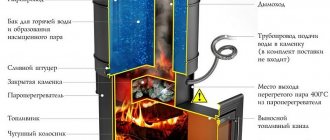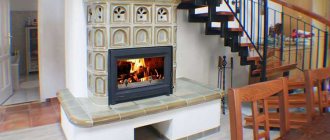The purpose of the grates
Thanks to the furnace grates, a uniform and efficient combustion of solid fuel in the furnace is ensured. As it burns, the ash spills into the blower, and the top layer of fuel goes down below, where there is a fresh air supply for full combustion. Moreover, grate bars help to dry damp wood.

If the design of the grate affects the efficiency of the furnace, then their durability depends on the material of manufacture. Please note that for the full operation of the furnace equipment, it is important to correctly install the grates.
Practical advice for choosing
When choosing a specific model, consider the type of fuel you will be using. For example, for coal, a design of 350 or 30x205 mm is suitable, and for firewood and briquettes - from 140x120 mm to 330x252 mm. The grate must be taken in such a way that the rods withstand the maximum possible weight of one portion of fuel. You can find out how much a particular model can withstand from the seller. If in doubt, consult a specialist.
In order for the grate to be well cleaned of ash, the gaps should occupy at least 40% of the area of the entire structure. If there are fewer of them, the firebox will work less efficiently, because the amount of air supplied is not enough for intensive combustion. Gases can accumulate if ventilation is insufficient. If the area of the gaps is larger, then unburned fuel will be poured into the gaps along with the ash.


Round grates
Typesetting and solid options
In different stoves, the furnaces may differ not only in size, but also in shape. In this regard, grate manufacturers produce a large assortment of products, so you can pick up grates for the firebox, even with a non-standard shape.


By structure, they are distinguished:
- Solid grates... In this case, a product is produced that cannot be disassembled into parts. They are produced in several standard sizes, so when selecting a product, you need to rely on the total area of the fuel chamber of the furnace.
- Type-setting grilles assembled from several parts. From such components, you can assemble a grate for a furnace of the desired shape and size.
Grid design
The size of the grate depends on the fuel to be used in the future. For use in everyday life, designs of two options are recommended - one-piece and composite.
The first option consists of a cast iron grate, which is selected according to the size of the combustion chamber. The second type is assembled from separate elements.
The size of a composite grate is determined in the same way as a solid one, according to the dimensions of the firebox. In addition to the species difference, the devices are also divided according to their functional functions.


The design of the cast-iron grate is of two types: full-revolving and swinging. In the first case, the elements have the ability to rotate horizontally by 180 degrees, which allows ash and slag to be dumped.
This design assumes a groove in the combustion chamber for additional holes. It is extremely difficult to make a full-turn system at home.
What are the grate structures
If we talk about products made of heat-resistant steel, then there are pipe and chain varieties of grates.


As for the cast iron grates, there are several types of them:
- Tiled... Such rectangular grates are widely used in solid fuel stoves and boilers, fireplaces. We can say that these are universal products. You just need to correctly select the size of the lattice.
- Basket... This type of grate was used in open hearths where food was prepared. Nowadays, they practically do not occur.
- Beam... Outwardly, such grates are like beams for construction. They are single or double typesetting parts, from which you can build a lattice of any size.
- Movable grates... The peculiarity of this design is that the lattice links can be moved in the horizontal plane, changing the gap between them. As a rule, such grates are used for long burning furnaces.
We select grate bars
Before installing the grates in the stove, you should decide on what kind of fuel you plan to heat it with. If coal will be used, then a grate of 350 × 205 or 300 × 205 mm is needed, briquettes and firewood require grates with sizes from 140 × 120 mm to 330 × 252 mm. The sizes of cast iron grates for the stove are quite diverse and it is not difficult to choose the size. Please note that the grate must be strong enough to support the maximum weight of one load of fuel. The strength characteristics should be checked at the point of sale.


The gaps between the grating bars should optimally occupy about 40% of its area, so that it is cleaned of ash in time. Narrowing the gap between the rods will lead to a decrease in air access and, as a result, a decrease in the efficiency of fuel combustion. In addition, inadequate ventilation can lead to gas build-up. On the contrary, too large gaps between the grates will not allow the fuel to burn to the end - some of the small fragments of unburned fuel will prematurely fall into the ash pan.
How much does a cast iron grate cost?
A cast iron grate designed for installation in a stove or fireplace can purchase, on average, at the following prices:
- A product of the KP-5 model, the size of which is 800 by 200 millimeters, will cost from 1,100 to 1,500 rubles.
- Models KP-6, size 915X250 mm - from 1,000 to 3,170 rubles.
- KP-7, 260X54.5 will cost 400 - 450 rubles and so on.
You should buy this accessory for installation in the oven in specialized stores that have a wide selection of similar high quality products. You can safely focus on two main parameters - the weight of the product and its price. It should be remembered that a cast iron grate cannot have a small mass and a low price.
Usually it is made from a special heat-resistant cast iron grade - SCh 15 (20). Manufacturers sometimes save on materialusing low quality steel. An accessory made of such a material, of course, is cheaper, but it quickly loses its operational properties and requires replacement.
The product will last the longest in the form of a beam with a ribbed surface. In this case, the contact area of the metal with an aggressive environment is minimized as much as possible, which will significantly extend the service life of the accessory.
DIY grate installation
Since all metals have the property of expanding under the influence of high temperatures, the grate should be laid with gaps on each side of at least 5 mm. To make the grates for the stove with your own hands as best as possible, it is worth cutting off a ledge in the fuel chamber - the edges of the grate will be laid on it.


Please note that inside the firebox, the grate is usually located on the brick below the door so that the burning coals do not fall out. In addition, it is undesirable to overwhelm the lattice, since this can lead to deformation of the metal or cracks in the masonry due to thermal expansion. After placing the grates in place, the gaps are filled with plain sand without cement.
If there is a lattice with triangular rods, it is laid down in triangles.
About solution
Now about the solution. We will not describe in detail - this has already been discussed many times, including on this site.
A mortar of clay and sand. The proportions depend on the fat content of the clay. The most common 1: 3.Grinding size does not matter.
It's a good idea to add sheet asbestos soaked in water - it reinforces the clay. It will crack less.
It is better to seal the cracks on a heated masonry, previously moistened with water. We clog large cracks with a mortar with brick fragments or corded asbestos soaked in clay. It can be replaced with a basalt cord. With the same cord, we seal the seams between the tanks (hot water, the input of the heat exchanger-register, etc.) and the brickwork.
First, we clean the cracks from the old solution and soot. Soot is easily removed by rubbing with wet clay. As soon as the clay starts to stick to the brick, it is normal. Otherwise, there will be no strong connection - soot interferes with the adhesion of the clay. When repairing the hearth and grate seat, the masonry must also be clean.
The designs of modern stoves are constantly being improved, changed, supplemented. However, there are elements whose functions are difficult to do without. As an example, you can put a grate for a stove (grate).
The grate is a part of the combustion chamber that supports logs, coal, fuel briquettes. Through the slots in it, ash falls down, freeing up space for a fresh portion of fuel. There are different design solutions for these elements, they are made of different materials. From the article you will learn how to choose and how to put the grate in the oven correctly.
Cast iron grate for a flat stove
findings
So, before you install the grates in the oven, you should choose them correctly. Cast iron products are considered the best option - they are equally suitable for both brick and steel stoves.
During the selection process, pay attention to the size of the gaps between the rods and the area of the grate, as well as the type of fuel. Installing monolithic models is a little easier, but the type-setting ones can be selected individually according to the size of the firebox.


Do not forget about expansion gaps around the perimeter of the grille and do not overwrite it.
Provided that all the subtleties are observed, the installed grate will not need to be replaced for a long time.
Why do you need it?
As it has already become clear, the grate is a grate that allows the air flow to penetrate directly to the combustion center below, and ash is removed through the holes in a specially designated place for it. So what are the grates in the oven for? Installing the grate in the oven allows you to solve a number of tasks:
- Divides the combustion chamber into two zones - the combustion chamber itself and the ash niche.
- It is used for fuel placement and drying.
- Distributes the air flow from the ash pan.
- Promotes good traction.
- Together with the door, it makes it possible to control and regulate the flame.
It is not possible to make a grate, which is intended for installation in a stove, from any metal. Since it is constantly in an environment of high temperatures and under the influence of oxygen, it can begin to oxidize very quickly. Only cast iron can hold out for a long enough time in this environment.















